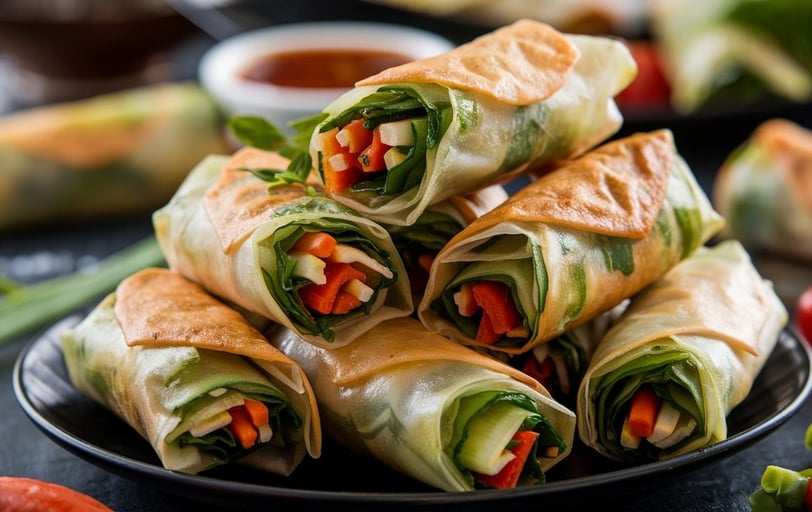How to Prepare Delicious Vegetable Spring Rolls
FOOD
10/18/20244 min read


Introduction to Vegetable Spring Rolls
Vegetable spring rolls are a vibrant and healthy choice for appetizers or snacks, enjoyed by individuals around the globe due to their refreshing taste and aesthetic appeal. Originating primarily from Asian cuisines, spring rolls have become iconic in numerous cultures, signifying a variety of culinary traditions. Traditionally, these rolls consist of thin rice paper enveloping a selection of fresh vegetables, herbs, and sometimes protein, creating a versatile dish that can be tailored to individual preferences.
The popularity of vegetable spring rolls can be attributed not only to their delicious flavor but also to their cultural significance. In countries like Vietnam and China, these rolls feature prominently in celebrations and family gatherings, embodying a sense of sharing and togetherness. They can serve as an appetizer or a light meal, making them suitable for various occasions, from casual dining to formal events. Additionally, the act of rolling these vegetables in rice paper can become a fun and engaging experience, especially when preparing them with friends or family.
Health-wise, vegetable spring rolls offer notable benefits, as they are often packed with fiber, vitamins, and minerals from the assortment of fresh vegetables used. The choice to create them at home allows for greater control over ingredients, ensuring a nutritious option that fits one’s dietary needs. Moreover, using seasonal produce can enhance both the flavor and the nutritional profile of the spring rolls, accommodating various tastes and preferences. Overall, the flexibility and healthful nature of vegetable spring rolls make them an inviting culinary endeavor for anyone looking to explore delicious and nutritious food options.
Essential Ingredients for Vegetable Spring Rolls
When preparing delicious vegetable spring rolls, the selection of fresh ingredients is crucial for achieving the perfect combination of flavors and textures. The primary component of any spring roll is the variety of vegetables used. Key vegetables include carrots, which add a satisfying crunch and natural sweetness; bell peppers, available in vibrant colors that enhance both visual appeal and taste; cucumbers, providing a refreshing and juicy element; and lettuce, which serves as a delicate wrap around the other ingredients.
In addition to these staples, incorporating herbs such as mint and cilantro is essential. These herbs not only elevate the flavor profile but also bring a fragrant quality to the dish. Mint offers a cool, invigorating taste, while cilantro adds a fresh, slightly citrusy note. Together, they create a harmonious blend that complements the vegetables beautifully.
Another critical component is the rice paper wrappers, which encase the veggies and herbs. These thin sheets become pliable when soaked in warm water, making them easy to wrap. It is important to choose high-quality wrappers to ensure that they are resilient and can hold the filling without tearing.
While traditional vegetable spring rolls do not include protein, adding options such as tofu, shrimp, or cooked chicken can enhance the nutritional value and satisfaction. Each protein contributes its unique flavor and texture, allowing for versatility in recipe customization.
For dipping sauces, consider options like soy sauce, hoisin, or peanut sauce. These sauces not only provide additional flavor but also complement the freshness of the vegetable spring rolls. Ultimately, the combination of these ingredients will determine the success of your culinary creation, making it essential to select each one thoughtfully.
Step-by-Step Preparation Method
Preparing vegetable spring rolls requires a systematic approach to ensure that each roll is not only delicious but also visually appealing. Start by gathering all the necessary ingredients, which typically include a variety of fresh vegetables such as carrots, cucumbers, bell peppers, and herbs like mint and cilantro. Begin the preparation by thoroughly washing and drying the vegetables.
The first step involves chopping the vegetables into julienne strips. This technique ensures that the vegetables fit neatly within the rice paper wrappers. Use a sharp knife for clean cuts, and try to maintain uniform sizes to enhance the presentation of the rolls. It is advisable to use colorful vegetables to create an eye-catching array that will appeal to the senses.
Next, you will need to soak the rice paper wrappers. Fill a shallow bowl with warm water and gently place a wrapper in the water for about 15-20 seconds, or until it becomes soft and pliable. Be cautious not to over-soak the wrappers, as this can lead to tearing during the rolling process. Remove the wrapper and place it on a dry surface, ensuring it is flat and ready for filling.
With the wrapper laid out, place a small amount of the prepared vegetables and herbs towards the bottom third of the wrapper. Be mindful not to overfill, as this could cause difficulty in rolling. Start rolling the wrapper up gently from the bottom, tucking in the sides as you go, to create a tight and secure roll. A key tip is to maintain a consistent pressure while rolling to prevent any gaps.
Finally, allow the assembled rolls to rest for a few minutes. This helps the rice paper to adhere securely. Common mistakes to avoid include overfilling the rolls, which can lead to messy outcomes, and improper soaking of the wrappers, resulting in tears. By following these steps precisely, you will create beautiful and appetizing vegetable spring rolls that are sure to impress.
Serving Suggestions and Dipping Sauces
Presenting vegetable spring rolls in an aesthetically pleasing manner not only enhances the visual appeal but also elevates the overall dining experience. A well-arranged platter can turn a simple dish into an impressive centerpiece for any meal. To serve your spring rolls, consider placing them on a large, flat platter, neatly arranged in rows or circles. Such presentation can be further enhanced by garnishing the dish with fresh herbs like mint or cilantro, providing vibrant colors and enticing aromas that complement the rolls.
Dipping sauces play a crucial role in accentuating the flavors of vegetable spring rolls. Traditional options such as sweet chili sauce and peanut sauce are always popular. Sweet chili sauce offers a perfect balance of sweetness and spice that can elevate the fresh taste of the vegetables. On the other hand, a homemade peanut sauce can add a rich, creamy texture that enhances the overall flavor profile. To prepare peanut sauce, blend smooth peanut butter with soy sauce, lime juice, and a touch of garlic for a delightful combination.
For those looking for innovative options, consider experimenting with a tangy soy-based dipping sauce by mixing soy sauce, rice vinegar, and sesame oil, topped with a sprinkle of sesame seeds. Another unique option involves mixing hoisin sauce with freshly grated ginger and a dash of lime, creating a zesty, flavorful dip that pairs beautifully with the fresh ingredients in the rolls.
Creative serving ideas can personalize the dish further. For instance, individual dipping bowls can be set alongside each roll, allowing guests to choose their preferred sauce. Alternatively, consider arranging spring rolls vertically in tall glasses for a modern presentation. Such serving suggestions not only enhance visual appeal but also provide a delightful experience for your guests as they enjoy the combinations of flavors.
Wellness
Explore beauty tips and holistic health insights
contact us
Balance
sapwans2005@gmail.com
© 2024. All rights reserved.
